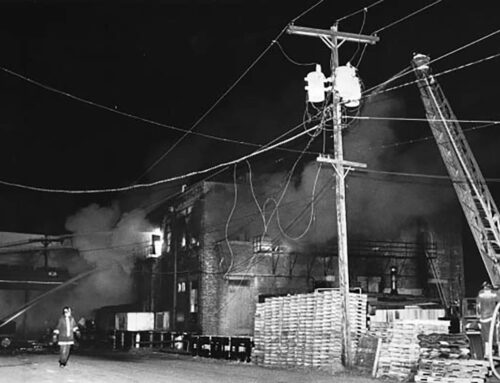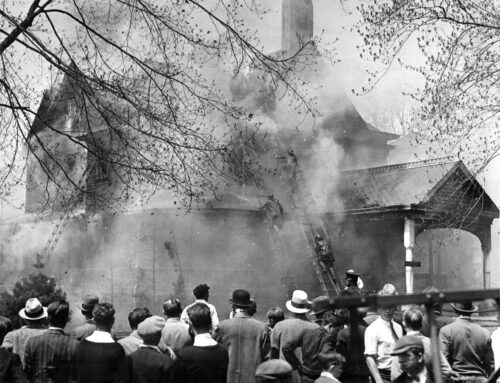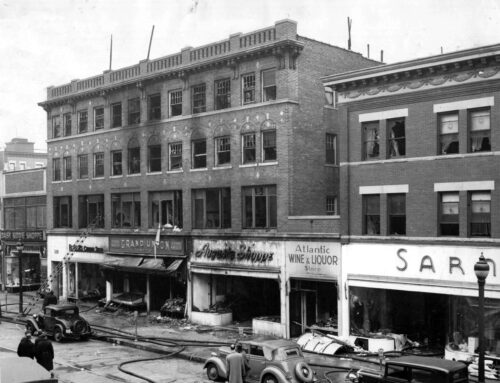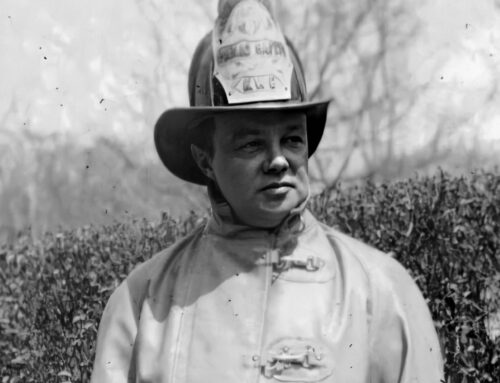Handtub
“a fire-fighting apparatus consisting of an often tub-shaped reservoir of water pumped out through a hose by means of a pump with brakes that are rocked up and down by a number of men on each side of the apparatus. … Also called a hand pumper or hand engine or Enjine.”
Introduction
Stamford’s Known Handtubs in History
- 10 Dec 1844 – Engine Company No. 1 – Named Rippowam
- 18 May 1854 – Engine Co. 2 – 5-1/2″ Handtub manufactured by Hunneman. Mfgr’s No. 504
- Circa June 1855. Engine Co No. 1. A 10-inch Handtub manufactured by Button of Waterford. Named Rippowam
- 27 Apr 1858 -Engine Company No. 2 – A 10-inch Handtub manufactured by Button of Waterford. -Named the Gulf Stream – Mfgr’s No. 476
- 1 Sep 1859 – Engine Company No. 1 – Most likely manufactured by Button Works. Bought used from Troy , NY – Named “The Good Intent”
“At a fire, these pumpers were operated by “strings” of men lined up shoulder-to-shoulder on each side of the engine, gripping a 25-ft. long bar or “brake” which served as the pump handle. The men pumped see-saw fashion to develop pressure at the nozzle. The more furiously they pumped, the farther and higher the stream. Every few minutes an exhausted man would jump out and a rested man jump in, a hazardous maneuver requiring exquisite timing, or immediate medical attention. Hand engines were normally pumped at 60 strokes per minute and a man would last about 10 minutes. When pushed, the speed would rise as high as 120 strokes per minute, but a man could last only one to three minutes. The men sometimes stood in rows three or four men deep, moving up to take their turn, then dropping back to the rear for a brief rest.”
While scouring the archives of the Stamford Advocate, it becomes readily apparent that fire was a significant problem for early Stamford citizens. There are countless news articles mentioning fires in the Borough of Stamford. The Burgesses would often address fire protection with fire safety regulations, fines and Fire Wardens to enforce them. But in the 1830’s, the beginnings of organized fire protection began to form as groups of volunteers banded together and formed “fire companies”.
The challenge of telling the early story of Stamford’s fire companies and their apparatus is that organizations, Burgesses, and the Wardens were regularly reorganizing how fire protection would be provided. Volunteer companies were organized, renamed, and disbanded frequently in an effort to improve fire protection or in response to new apparatus purchases.
1820-1829
The earliest reference to a Stamford Fire Company is found in May 1829, in a resolution authoring the first Stamford fire company. “It shall be called the Stamford Fire Engine Company”, the resolve said. The intent was for this company to have a “fire engine, but it is not clear whether it was a pumping hand tub or more of a bucket brigade tool transport vehicle. Most believe that it was more of a tool used by a bucket brigade.

1830 – 1839
In November, 1830, the editor of The Sentinel in Stamford, CT. wrote:
“Whatever became of the fire engine left in this Borough, for trial of its powers, a few weeks since, preparatory to make a purchase? We believe those who were anxious to obtain one, have forgotten the circumstance, as we have hardly heard it named of late that a machine of the kind was in the neighborhood…., We invite the attention of all those concerned to the subject tomorrow afternoon at 4 o’clock, at Mr. Waring’s. Punctual attendance of the members of the Fire Company would be gratefully acknowledged by all interested in devising some measure to guard not only private but public property from destruction by fire. The cold season fast approaches when fire becomes necessary to comfort, and destruction of property by its getting the mastery is the most frequent.”
Later that month, a meeting was called to discuss the raising of a tax to pay for a new fire engine ..
Although it is not clear whether a “fire engine” was ever obtained, the Fire Company was formed. In December 1830, members of “Fire Company No. 1 met for the purpose of electing officers and transaction business. There are no know records of this Company, so it is not clear whether they actually formed.

1840-1859
Fourteen years later, with just $24.71 in the borough treasury, the Burgesses set out to see what a new fire engine would cost, and what amount of taxable property was in the Borough that could help pay for it.
On August 11, 1844, it was “resolved that the borough will purchase two fire engines with hose, hooks, ladders, etc. as the necessity of the Borough may require.” To pay for the engine, a tax of 10 mills on the dollar was levied and James B. Scofield was paid ten dollars for collecting it. Although two engines were approved, only one was purchased.
On December 10, 1844, a “goose-neck” model, hand-drawn, hand-pumped fire engine from an unknown manufacturer was purchased. The Engine was placed in the charge of Sands Seely (Foreman) and the newly formed Rippowam Fire Company #1. The “machine” was given the name, “The Rippowam”. The cost of this handtub was $500. The borough also purchased 197 ft. of hose for $118.20.


In the Spring of 1846, an engine house was erected in the rear of the Town Hall, which stood on Atlantic Square. roughly where the old Town Hall building on Bank Street stands today. This became the firehouse of Rippowam Engine Company #1 and stood for 25 years. For the first 10 years, it was Stamford’s only firehouse. It probably was a very simple building; the engine and accompanying hose carts were small and hand-drawn. There were no horses yet to draw the apparatus.
1850- 1859
For almost a decade, “The Rippowam” was the only fire apparatus in the Borough. In December 1853, a public meeting was called to discuss the purchase of a new fire engine. According to news accounts, it was a large and enthusiastic meeting. A resolution was proposed to effectively “dispose” of the 1849 Rippowam and purchase two new engines. After the pros and cons of the resolutions were discussed, a vote ended the debate. The resolution to purchase two new engines was defeated.

But in the Spring of 1854, a single engine was purchased by the Borough. The engine was made by the Hunneman Company of Boston. It was a 5-1/2″ engine and was scheduled to arrive in Stamford on May 16, 1854. It was the bearer of the maker’s number 504. This engine was named “Stamford No. 2” or “The Stamford.” It cost $725 and was fitted with $325 worth of suction and hose.
It was proposed that when the recently purchased engine arrived, a new engine company be formed to take charge of it. Hence, the birth of Stamford Engine Company No. 2.

There are some indications from a May 23 1854 news article that there was some disappointment with the new engine in its trial performance.

In consideration of $1.00, the borough leased for a lot near the Phoenix Company’s factory. The lot measured about four rods bounded east by Gay St., north and west by our own land, and south by land of the Union Co. The term of the lease was 10 years. A new engine house was built for Stamford Fire Engine Company No. 2 on this Gay Street location for $569.
Meanwhile, just a year later, in 1855, Rippowam Engine Company appears to be getting a little jealous of Company No. 2’s new Engine.
With the Rippowam Fire Company #1 still operating its 1846 hand tub, we see that the Rippowam Engine Company No. 1 was in the market for a new and more powerful engine. According to a April 17, 1855 Advocate newspaper article, the members of the Company would raise, by subscription amoung themselves, $400 while seeking the balance from the Borrough.

A month later, on May 7th, the Wardens and Burgesses appropriated $800 to aid Rippowams efforts for a new fire engine and hose.

On June 19, 1855, the Stamford Advocate reported that the Borough had approved the sale of the first Rippowam, presumably, once the new apparatus arrives.

In July, the Rippowam Engine Company took charge of their new 10” Button Fire Engine, while retiring its old gooseneck engine. The new engine inherited the name “Rippowam.” The original Gooseneck “Rippowam” was sold to the Stamford Manufacturing Company in the Cove.


The Rippowam Fire Company No. 1, lost no time entering their new engine into regional competitions.
- September. 28, 1855
Springfield, Massachusetts
Made a perpendicular play through 300 ft. of hose of 109 feet.
It finished 14th on a list of 22 engines. - September 5, 1856
New Haven, Connecticut
Made a perpendicular play through 450 ft. of hose, of 153 ft.
Won first prize of $500, defeating 20 other engines, including many of the best known in the region. - September 24, 1857
Hartford, Connecticut
Made a horizontal play through 400 ft. of hose, of 147 ft., 9 in.
Finished 14th on a list of 39 engines.” - September 8, 1858
Worcester, Massachusetts
Finished last with 112 feet.
It is presumed that the engine may have experienced some mechanical trouble
On November 18 and Dec. 2 1857, No. 2 Engine Co. held meetings to discuss purchase of a larger engine. The Jeffers company in Pawtucket, RI offered one for $1700 with a $200 trade-in of the Hunneman. After much comparison, a 10″ Button engine was decided on, a much improved version of the current “Rippowam” in town.
The new 10-inch Button handtub arrived in April 1858 and was greeted with accolades. It bore Mfgr’s No. 476 and was given the name “Gulf Stream”. With the naming of their new apparatus, Stamford Engine Company No.2 became the Gulf Stream Engine Company No. 2.

In a meeting of Stamford Fire Engine Co. No. 2 held Dec. 2, 1857, a motion was carried to “procure a hose carriage and…the cost shall not exceed $200.00 and the committee appointed for the purpose to be instructed to procure one suitable for the new engine.” They chose a two-wheeled hose carriage that could either be drawn by hand or coupled behind and hauled with the engine.
As is common with volunteer companies of the day, the Stamford Hose Company #2 quickly signed their new engine up for its first muster. But this one was different… it was quite some distance from Stamford… 160 miles away in Albany, New York. At Fire Company expense, they chartered the steamer “Massachusetts” at a cost of $425.00 to take the new engine up the Hudson. The Gulf Steam performed exceptionally well.
September 30, 1958,
Albany, New York
Made a perpendicular play of 149 ft. through 300 ft. of hose.
Won second prize of $400
The “Franklin 3” of Brooklyn won first prize with a perpendicular play of 152 ft. The engines were classed at this muster. The Gulf Stream was in the first class of which there were 12 handtubs.
With few fires to keep them busy in the late 1850’s, the two Stamford fire companies and their two 10″ button engines competed lustily, not just in racing to fires, but “sometimes with an engine on either side of the Congregational Church on Atlantic Square, The rivals would try to be first to lob geysers over the church roof…probably the tallest in Stamford”…drenching the losers on the other side.
In September 1859, the Rippowam Company purchased a used engine, It was s name the “Good Intent No. 13” and was brought from a fire company in Troy, New York. Rebuilt and modernized, it took the old name “Rippowam.” writes HH Easterbrook in 1911. “It probably had folding brakes similar to those of the recently purchased “Gulf Stream”. It is not clear what happened to the famed second “Rippowam”. It seems to have just disappeared.
1860-1870
On October 9, 1862, the Stamford Advicate reports the arrival of Stamford first Hook & Ladder truck.
“Yesterday afternoon, the handsome truck, manufactured in Waterford, N.Y., arrived in this village. The Engine Companies assembled at the depot, where a procession was formed of firemen and citizens; and its advent in Stamford was the occasion of appropriate ceremonies. In the evening there was a collation at the engine house.”

The fact that this apparatus was manufactured in Waterford, New York indicates that this hook and ladder trucks was manufactured by Button Works.
The new Hook and Ladder Company rented a building formerly occupied by N. B. Bennett, a tinman who had gone to the war. The building was overhauled with a spacious door to accommodate the truck. Numerous other alterations were made.
“The truck is a valuable addition to the fire department, and to the chief engineer and others who have so arduously labored for its introduction, great praise is due. With the truck and our two engine and hose companies, we can no almost bid defiance to the ‘raging element.”
On August 8, 1867, the Advocate reports that “the Rippowam Engine Company have had their engine thoroughly overhauled…The Company is now well organized…”
1880 – 1890
The Borough turn quite for about a decade when it came to the purchasing of new fire apparatus. But in February 1883, Stamford purchased its first steam pumper, a Button. And with this purchase, comes the end of hand-drawn fire apparatus. Several new apparatus purchases were in the pipeline, all requiring horses to draw the heavy equipment. Could this be a major contributing factor that caused an end to Stamford’s volunteer fire companies and the rise of a paid Stamford Fire Department in 1885?
1890 – 1900
On October 4, 1892, Stamford sold the old Gulf Stream engine (Mfgr’s No. 476) to New Canaan. They would use it to move water in town while an aqueduct was built from the reservoir.

Meanwhile, in the Cove, the original 1844 Rippowam continued to serve Cove Fire Engine Co 1, which was not part of the Stamford Fire Department. In the Stamford Anniversary Parade of 1892, the Advocate mentions the old engine and the Fire Company participating in the parade.

After just a few years serving New Canaan’s Water Works, the Gulf Stream was “shelved.” But no for long. The Gulf Stream would soon begin a Northeast tour of duty serving numerous departments.

In February of 1896, New Canaan sold the old Gulf Stream Engine to Providence, Rhode Isand. The price was not disclosed.
By the end of the year, Providence would sell the Old Gulf Stream Engine to Fall River Veteran Fireman’s Association.
“The Combination Ladder company of Providence, R. I., has sold to the Fall River Veteran Firemen’s Association, a ten-inch Button hand engine, the Gulf Stream, which formerly belonged to the town of New Canaan, Conn. This machine was originally owned in Stamford, Conn., and has a record as a prize winner. She won one prize of $250 in gold at Albany, N. Y. As part payment, the General Taylor engine from Fall River was taken in exchange”
The Gulf Stream would be used by the Fall River Veteran Firemen’s Association for numerous years, competing in multiple musters accross the region.

1910 – 1920
The Original Rippowam Comes Home!
On July 31, 1915, General Skiddy of the Stamford Manufacturing Company presented the old Rippowam Engine to the Stamford Fire Department.

The Rippowam was placed on the third floor of the new Central Fire Station in what became known as the Relic Room. It remained there for quite some time, occasionally being taken out for parades.
But what happened to the old machine is not known. It was last seen in parades in the mif 1950’s. Is it in someone’s basement? Was it discarded? Or as one report suggests, was it broken up for firewood to support the war effort? We may never know, but this relic would be one that I am sure we would all love to see again.

In 1919, the old Gulf Stream is found in Bath, Maine still pumping away.

1849
The old Gulf Stream’s regein comes to an end when it is reportedly broken apart for parts. Those parts were used in Bath’s Sagadohoc #2 hand tub.







